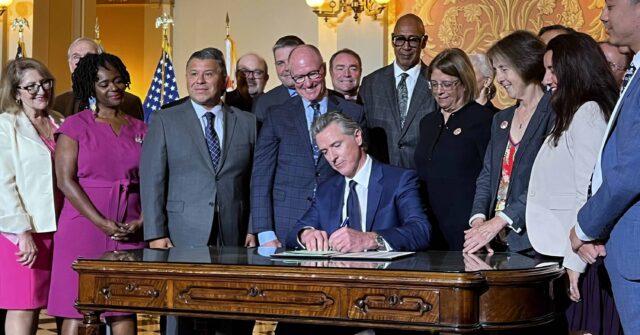California Governor Gavin Newsom has recently enacted legislation aimed at addressing high gas prices in the state, yet the measures do not address some of the key underlying issues contributing to those prices. Despite claims of taking action, Newsom has opted not to lower taxes, suspend the state’s “cap-and-trade” system, or alter the stringent regulations governing refineries. These components have been identified by industry experts and analysts as significant factors that result in California having the highest gas prices in the U.S., averaging $4.677 per gallon compared to the national average of $3.203. Instead, the legislation introduced requires refineries to maintain extra fuel supplies to minimize price volatility, shifting the focus of blame onto the oil and gas industry.
In previous legislative sessions, Newsom has pursued a series of laws that similarly aimed at curbing what his administration termed “price gouging,” culminating in a penalty for excess profits realized by oil companies. However, these efforts have thus far proven ineffective, as gas prices remain largely unchanged despite attempts to regulate them. Newsom’s insistence that action is necessary to prevent price spikes and protect consumers is contradicted by his inability to deliver tangible results through past legislative efforts. In comments following the new law’s passage, he cited a commitment to prevent supply shortages that can drive up costs, but he did not provide any explanations for previous failures in addressing the crisis.
The recent law is part of Newsom’s broader narrative, in which he holds the oil and gas industry responsible for the financial burden placed on Californians due to skyrocketing fuel prices. He argues that maintaining excess fuel supplies will enhance preparedness against potential supply disruptions, which he claims will ultimately benefit consumers at the pump. However, critics assert that merely requiring refineries to have backup supplies does not fundamentally solve the underlying issues at play, including the taxation structure and the existing cap-and-trade framework which many believe contribute to elevated fuel prices.
Republican representatives have voiced frustration over the exclusion of their proposals during the special legislative session. Notably, they advocated for measures such as exemptions for transportation fuels from California’s cap-and-trade regulations, which they argue would help alleviate some price pressures faced by consumers. The refusal to consider these proposals highlights a political stalemate in addressing the multifaceted problem of high gas prices. While Newsom continues to emphasize preventative measures against price increases, skeptics point out that legislative options that could provide immediate relief were discarded, limiting the effectiveness of the state’s current approach.
Newsom’s rhetoric suggests a steadfast commitment to action in the face of a perceived industry failure, but the outcomes of his previous initiatives raise concerns regarding the efficacy of this latest law. Since he took office, Californians have grappled with inconsistent and high fuel prices, leading to calls for a comprehensive reassessment of the policies and regulations affecting the oil market. The continued burden on consumers coupled with the administration’s reluctance to consider tax and regulatory reforms reflects broader challenges in California’s pursuit of affordable energy.
In summary, while Governor Newsom has introduced a new law to tackle the issue of high gas prices in California, the lack of substantive changes to taxes and regulations that significantly impact fuel costs raises questions about the efficacy of his approach. His emphasis on industry accountability and supply management introduces a narrative of proactivity, but analysts and critics alike suggest that without addressing the foundational systemic issues, Californians will likely continue to face elevated prices at the pump. As the Governor’s office embarks on further legislative efforts, the effectiveness of the new law, alongside the educational efforts to inform and involve constituents about these challenges, will be critical in shaping public sentiment and future policy initiatives.

